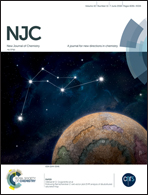Comprehensive insights into the interaction mechanism between perfluorodecanoic acid and human serum albumin†
Abstract
In this investigation, we explored the toxic effects of perfluorodecanoic acid (PFDA) on human serum albumin (HSA), established the interaction mode of PFDA with HSA, and provided a new strategy for the evaluation of toxicity of PFDA on functional proteins. The binding of PFDA and HSA forms a complex, and PFDA induces fluorescence sensitization of HSA. In addition, PFDA gives rise to a slight impact on the polypeptide chain and the microenvironment around Trp-214 from the spectroscopic angle. Moreover, the relative esterase activity of HSA was depressed by more than 60% upon the addition of 4 × 10−4 M PFDA. The thermodynamic parameters ΔG, ΔH, and ΔS were −7.2683 kcal mol−1, −2.718 × 104 ± 0.5308 × 104 cal mol−1, and −66.8 cal mol−1 K−1, which indicated a spontaneous interaction, in which van der Waals’ forces and intermolecular hydrogen bonds were the predominant driving forces. In addition, molecular simulation has been performed to determine the specific binding site, which has revealed that PFDA most preferably binds with Tyr-411 by a hydrogen bond and the distance between the hydroxyl of PFDA and Tyr-411 is 2.64 Å, in accordance with the results of thermodynamic analysis and HSA functional analysis.



 Please wait while we load your content...
Please wait while we load your content...